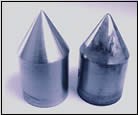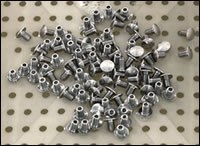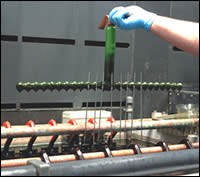Making Stainless Steel Stainless
Choosing a passivating or electropolishing process for your parts.
Parts and components machined from stainless steels must be passivated to maximize their essential corrosion resistance. Good passivating practice can make the difference between satisfactory performance and premature failure, while poor practice can actually cause corrosion.
The passivation process is sometimes misunderstood. It’s not a scale removal treatment, nor anything similar to a coat of paint. It is a post-fabrication method of maximizing the inherent corrosion resistance of the stainless steel from which the workpiece was made.
Protective Film
Not everyone agrees on the precise mechanics of how passivation works. It is certain, however, that a protective oxide film exists on the surface of passive stainless steel before it is fabricated. This invisible film is extremely thin—about 100,000 times thinner than a human hair. Clean, freshly machined, polished or pickled stainless steel parts automatically acquire this protective film from exposure to oxygen in the atmosphere. Under the best conditions, this oxide film covers all part surfaces.
The need for passivation arises when parts are fabricated, either by cold forming or machining. Contaminants such as shop dirt or iron particles from cutting tools may be transferred to the surface of the stainless steel parts during fabrication. These foreign particles can reduce effectiveness of the original protective film, and corrosive attack may begin if they are not removed. Rust spots on machined parts, for example, are actually caused by corrosion of foreign particles from tooling, not the parent metal. Sometimes the crevice at the embedded tool steel particle or its corrosion products may cause attack of the part itself. Likewise, small particles of iron-containing shop dirt may stick to the stainless part surface. Although the metal may appear shiny in the as-machined condition, the invisible particles of free iron can cause rust on the surface after exposure to the atmosphere.
Exposed sulfides, if ignored, can also create problems. They derive from the addition of sulfur to stainless steels to improve machinability. Sulfides improve the alloy’s ability to form chips that break away cleanly from the cutting tool during the machining process. If the part is not properly passivated, sulfides can act as initiation sites for corrosion on its surface of the fabricated product.
For stainless parts, a two-step cleaning/passivation procedure can provide the best possible corrosion resistance. First, grease, coolant or other shop debris must be cleaned from the surface to obtain the best possible corrosion resistance. Machining chips or other shop dirt can be wiped carefully off the part. A commercial degreaser or cleanser may be used to clean off machining oils or coolants. Foreign matter such as thermal oxides may have to be removed by grinding or by methods such as acid pickling.
Occasionally, a machine operator might skip the cleaning, falsely assuming that immersing a grease-laden part in an acid bath will effect both cleaning and passivation. That doesn’t happen. Instead, the contaminating grease reacts with the acid to form gas bubbles. These bubbles collect on the surface of the workpiece and interfere with passivation.
Flash Attack
Even worse, contamination of the passivating solution, sometimes with high levels of chlorides, can cause “flash attack.” Instead of obtaining the desired oxide film with a shiny, clean corrosion-resisting surface, the flash attack produces a heavily etched or darkened surface. This is a deterioration of the very surface that passivation is designed to optimize.
Following is a review of cleaning and passivation procedures for some specific types of stainless steels, which are summarized in Table 1.
| Table 1: Passivation of Stainless Steels with Citric and Nitric Acids | ||||||
| Stainless Family |
Example Stainless Steels |
10% by weight Citric Acid, passivated 30 min as below |
Nitric Acid, passivated 30 min at 120–140°F | |||
| ºF | pH(a) | Process(b) | Volume % acid(c) | Process(b) | ||
| Austenitic |
Type 304/304L, 316/316L
Custom Flo 302HQ
Type 305
Nitrogen-strengthened
|
150 | 1 |
20%
|
1 | |
| Martensitic-PH |
Custom 630 (17Cr-4Ni),
Custom 450, 455 and 465
15Cr-5Ni
|
150 | 1 |
20% + Na2Cr2O7
|
1 | |
| Ferritic |
Type 430
|
150 | 1 |
20% + Na2Cr2O2
|
1 | |
| Ferritic |
Type 409Cb
|
180-200 | 2 |
20% + Na2Cr2O7
Use care: low Cr
|
1 | |
| Martensitic |
Type 410 and 420,
TrimRite
|
120-130 | 2 |
20% + Na2Cr2O7
|
1 | |
| Austenitic FM |
Type 303
|
150 | 2 |
20% + Na2Cr2O7
|
2 | |
| Ferritic FM |
Type 430F, 430FR
|
NA | NA | NA |
20% + Na2Cr2O7
|
2 |
| Ferritic FM |
Chrome Core 18-FM
|
100 | 2 |
NA
|
NA | |
| Ferritic FM |
Type 409Cb-FM
|
110 | 5 | 2 |
20% + Na2Cr2O7
Use care: low Cr |
2 |
| Martensitic FM |
Type 416
|
110 | 5 | 2 |
Preferred vs. citric
20% + Na2Cr2O7 |
2 |
| a) pH adjusted with sodium hydroxide. b) Process 1: Clean/degrease, water rinse, passivate per table, water rinse, dry. Process 2: Clean/degrease in 5% by weight sodium hydroxide at 160–180°F for 30 min, water rinse, passivate per table, water rinse, neutralize in sodium hydroxide as in step 1, water rinse, dry. c) Na2Cr2O7 means add 3 oz/gal sodium dichromate to the 20% nitric acid. An alternative to this mixture is 50% nitric acid without sodium dichromate. |
||||||
Martensitic & PH Grades
Parts made from martensitic stainless steels (Type 410, 420 and 440 series) are magnetic, with moderate corrosion resistance and high yield strengths. These alloys are hardened at high temperature, then tempered to obtain desired hardness and mechanical properties.
Precipitation hardening (PH) stainless steels, such as Carpenter Custom 630, 450, 455 and 465) offer a better combination of strength and corrosion resistance than martensitic alloys. These PH grades are rough machined, aged at lower temperatures, then finish machined.
Workpieces made from martensitic and PH stainless steels must be thoroughly cleaned with a degreaser or cleanser to remove any traces of cutting fluid before heat treating. Cutting fluid remaining on the parts will cause excessive oxidation and can result in undersize parts with a pitted finish after the scale is removed by acid or abrasive methods. If cutting fluids are left on parts that are bright hardened, as in a vacuum furnace or protective atmosphere, surface carburization may occur, leading to a loss of corrosion resistance.
After thorough cleaning, parts are ready for immersion in a passivating bath. More corrosion-resistant, chromium-nickel stainless steels can be passivated in a 20% (by volume) nitric acid bath. Less resistant stainless grades—straight chromium, high-carbon/high-chromium and precipitation-hardened martensitic grades—can be passivated by adding sodium dichromate to the nitric acid bath to make the solution more oxidizing and capable of forming a passive film on the surface.
Another option is to increase the concentration of nitric acid to 50% by volume. Both sodium dichromate addition and higher nitric acid concentration reduce the chance of undesirable flash attack. Note that the 50% nitric acid concentration is more oxidizing and therefore less aggressive to stainless steels than 20% nitric acid.
Free-Machining Grades
The procedure for passivating free-machining stainless steels is somewhat different from that which is used with other alloys because the sulfides in sulfur-containing free-machining grades are partially or totally removed during passivation in a typical nitric acid bath. This creates microscopic discontinuities in the surfaces of the machined part. Even normally efficient water rinses can leave residual acid trapped in these discontinuities after passivation. Unless this acid is neutralized or removed, it can then attack the surface of the part.
To effectively passivate free-machining stainless steels, Carpenter Technology Corporation has developed the A-A-A (alkaline-acid-alkaline) process which neutralizes trapped acid. This technique can be done in less than two hours, and will provide corrosion resistance superior to a conventional passivation process.
The procedure:
a) After degreasing, soak parts for 30 min in a 5% solution of sodium hydroxide at 160–180ºF.
b) Water rinse the parts thoroughly.
c) Immerse parts for 30 min in a 20% by volume nitric acid solution containing 3 oz/gal sodium dichromate at 120–140ºF.
d) Remove parts from bath and flush with water.
e) Immerse parts in sodium hydroxide solution for another 30 min.
f) Water rinse and dry parts.
Citric Acid Baths
Citric acid passivation has been gaining favor with finishers who wish to both avoid the use of mineral acids or solutions containing sodium dichromate, and to eliminate the disposal problems and safety concerns associated with their use. Citric acid is considered environmentally friendly in every respect. It is on the GRAS (Generally Regarded As Safe) list compiled by the U.S. Food & Drug Administration.
Citric acid passivation is useful for a large number of stainless steel families, including several individual grades. Passivation treatments vary depending on chrome content and machinability characteristics of the grades in each family.
Laboratory tests indicate parts processed using citric acid passivation were more prone to flash attack than nitric acid-passivated parts. Causing factors included excessive bath temperature, excessive immersion time and bath contamination. Citric acid products containing corrosion inhibitors and other additives (for example, wetting agents) that reportedly reduce sensitivity to flash attack are commercially available.
The ultimate choice of a passivation process will depend on the acceptance criteria imposed by your customer. For more information, refer to ASTM A 967 (“Standard Specification for Chemical Passivation Treatments for Stainless Steel Parts”) at www.astm.org.
Electropolishing
Electropolishing is an electrochemical process used to polish a metal surface by removing a microscopic amount of material from the workpiece. It’s a frequently used method that more accurately conditions, rather than passivates the surface of a part. A part that has been electropolished requires no subsequent passivation.
This is the process of choice for parts and components that must have a very smooth, lustrous, mirror finish such as that required for surgical instruments. For bright-finish parts that reflect too much glare, glass bead blasting or buffing with a fine abrasive pad can tone down the surface finish.
Electropolishing is accomplished by creating an electrochemical cell in which the part to be polished serves as the anode. A cathode is formed to duplicate the geometry of the part surface, and the anode and cathode are submerged in a heated electrolyte bath. When a DC current is applied, an electrical charge dissolves metal ions from the part surface. For stainless steels, mixed acid solutions, including glycolic, phosphoric and sulfuric, are used as the electrolyte.
Because electropolishing removes surface material and contaminants, it improves the corrosion resistance of stainless parts. It also deburrs as it polishes the surface. The improved microfinish reduces product adhesion and contamination buildup.
Testing Treated Parts
Tests can be performed to determine how effective passivation has been in removing free iron and other exogenous matter from treated surfaces. These tests can be used on electropolished surfaces as well. Each of five test methods are described in detail in the previously mentioned ASTM A 967 specification. The test method employed must be matched to the grade to be evaluated. A test that is too severe may reject perfectly good material, while one that is too lenient may accept unsatisfactory parts.
The 400 series, PH and free-machining stainless steels are best evaluated in a cabinet capable of maintaining 100% humidity (samples wet) at 95ºF for 24 hr. The cross section is usually the most critical surface, particularly for free-machining grades. One reason for this is that the sulfides, elongated in the direction of working, intersect this surface.
Critical surfaces should be positioned upward, but at an angle of 15–20° from the vertical to allow any moisture to run off. Material that has been properly passivated will be virtually free of rust, although it may show some light staining.
Austenitic, non-free-machining stainless steels can also be evaluated using a humidity test. Liquid droplets of water should be present on the surface of samples, revealing free iron by the presence of rust formation.
A faster method is available using a solution from ASTM A 380, “Standard Recommended Practice for Cleaning and Descaling Stainless Steel Parts, Equipment and Systems.” This test consists of swabbing the part with a copper sulfate/sulfuric acid solution, maintaining wetness for six minutes and observing whether there is any plating of copper. Alternatively, the part may be immersed in the solution for six minutes. Copper plating occurs if iron is dissolved.
This test should not be applied to surfaces of parts for use in food processing. Also, it should not be used for the martensitic or lower-chromium ferritic stainless steels of the 400 series because false-positive results are likely.
Historically, the 5% salt spray test at 95ºF also has been used to evaluate passivated samples. This test, too severe for some alloys, generally is not necessary to confirm that passivation has been effective.
Read Next
A ‘Clean’ Agenda Offers Unique Presentations in Chicago
The 2024 Parts Cleaning Conference, co-located with the International Manufacturing Technology Show, includes presentations by several speakers who are new to the conference and topics that have not been covered in past editions of this event.
Read MoreDelivering Increased Benefits to Greenhouse Films
Baystar's Borstar technology is helping customers deliver better, more reliable production methods to greenhouse agriculture.
Read MoreEducation Bringing Cleaning to Machining
Debuting new speakers and cleaning technology content during this half-day workshop co-located with IMTS 2024.
Read More



















.jpg;maxWidth=300;quality=90)



